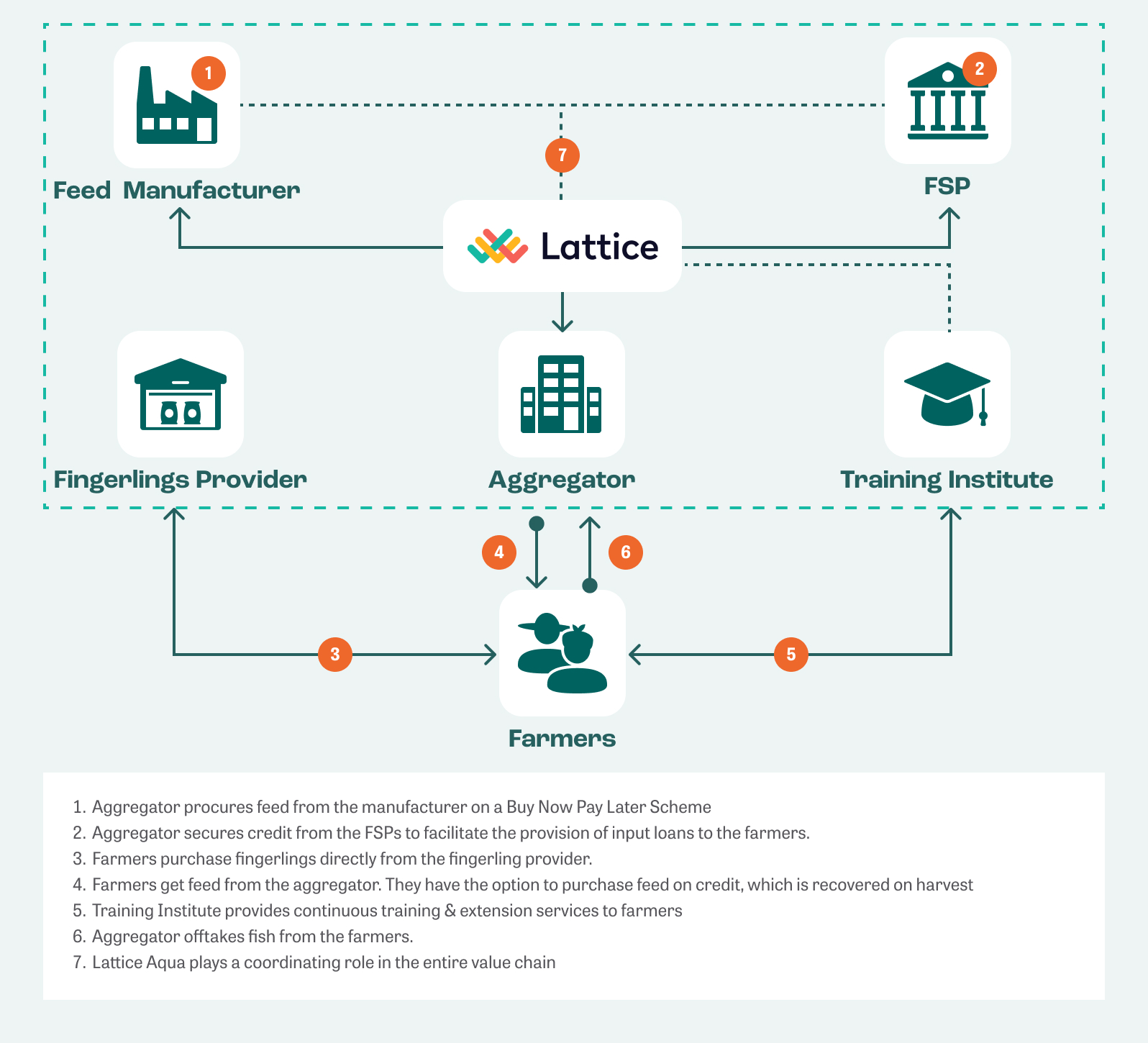A Service Coalition Structure to address Challenges in Kenya’s Aquaculture Value Chain
What is the Innovation?
A service coalition is a strategy that builds or strengthens horizontal coalitions of value chain players (VCPs) that coordinate the delivery of complementary goods and services to farmers. Players in the coalition benefit from sharing risk, cost, value created, and data, ultimately improving the effectiveness and sustainability of their businesses. Service coalition provides the benefit of specialized complex service provision while offering farmers a wide range of complementary services.
Key Challenges Addressed
The aquaculture sector in Kenya faces a myriad of challenges including; limited access to quality and affordable inputs (fingerlings, feed), training/capacity development, markets and finance. To address these challenges, Lattice Aqua and IDH convened several players - a fish aggregator (Aquarech), feed manufacturer (Tunga Nutrition), fingerlings providers (Kamuthanga and Jewlet), financial service providers, and a training institute (Aquaculture Academy), to create a service coalition structure that provides holistic services to farmers in the Eastern and Western parts of the country. Aquaculture farmers require specialized services, making the service coalition an ideal approach to provide the services cost-effectively and efficiently while leveraging the specializations of the different VCPs. The service coalition structure creates a sustainable approach to scale the development of the aquaculture value chain in Kenya while establishing modalities for effective and efficient service provision while reducing the risk of investment in the value chain. This will ultimately be pivotal in bridging the fish supply-demand gap in in the country.
How it Works

Tips for Replication
Context
- Highly fragmented value chain.
- Highly specialised and complex services.
Best Practices
- Clear demonstration of the value proposition for each VCP: Services provided by the VCPs are complementary thus creating value for all the players.
- Well-defined roles and reporting structures: Lattice is pivotal in the governance of the coalition, ensuring the VCPs effectively execute their roles while reporting on the progress made.
- Reduce dependency: Have multiple service providers for each service to reduce risk.
Enabling Conditions
- Digital infrastructure: A digital app that enables collection, monitoring and sharing of farm data and designed to meet the needs of the VCPs is critical.
- Synergies and alignment of strategy between the VCPs: Different players have aligned to support farmers to improve fish production.
Business Case
Expected Outcomes for value chain players
Increased Market opportunities
The availability of complementary services by the VCPs increase the level of demand for each individual good and service. This leads to increased farmer numbers and sales for each VCP. The Service coalition is projected to create combined value of up to $21 million annually at both farmer and VCP level.
Improved Access to data and information
Sharing of resources, infrastructure, data and information increases the efficiency and effectiveness of service provision while enabling the value chain players to improve their decision-making process. Aquarech has a mobile application that will be used to collect data at farm level, monitoring both quality and productivity.
Improved sector governance
Based on the learnings from the pilot, IDH and Lattice intend to convene more players in the aquaculture sector. Such convening efforts will be pivotal in aligning strategies and establishing robust governance structures, thereby improving sector governance.
Impact Case
Expected Outcomes for smallholder farmers
Increased Access to Services
Collaboration between the different value chain players enables farmers to access key services including training, access to markets, access to finance, and inputs. Farmers in the coalition are for instance able to get farm gate prices that are up to 6% higher compared to other farmers.
Increased productivity
Application of good aquaculture practices acquired through training enables achievement of 1.5 and 2 production cycles per year for pond and cage farmers respectively compared to 1 cycle for baseline farmers. Further the stocking density increases by 67% for pond farmers and 30% for cage farmers while fingerlings survival rate also increases by 25% for both.
Improved access to credit
Establishment of formal farmer groups with village savings and loans associations (VSLAs) scheme enables farmers to easily access credit from the VSLAs to finance their farm activities and other emergencies at the household level.
Outstanding Risks and Challenges
- The digital infrastructure for data collection is currently owned by one VCP, potentially posing a risk to effective data collection and sharing with other partners.
- Concentration risk with only one VCP per service poses a threat to the working of the coalition where the VCP is unable to provide the services as envisaged.
- Importation of raw materials for the manufacture of feed compromises the availability of affordable commercial feeds locally.
Data Sources & Disclaimer
Information is based on IDH’s Service Delivery Model (SDM) analysis for the Kenya Aquaculture program, under the Value Chain Development, including data from the value chain players. The Innovation is currently being piloted by IDH and Lattice as they implement a project with 50 initial farmers and five value chain players. The SDM assessed the capacity of the Value chain players, identified the gaps, and evaluated the commercial viability of fish farming for the 50 farmers with the potential to scale with an initial target of 625 farmers by the fifth year. A longer time span and additional data are needed to verify and quantify impacts.